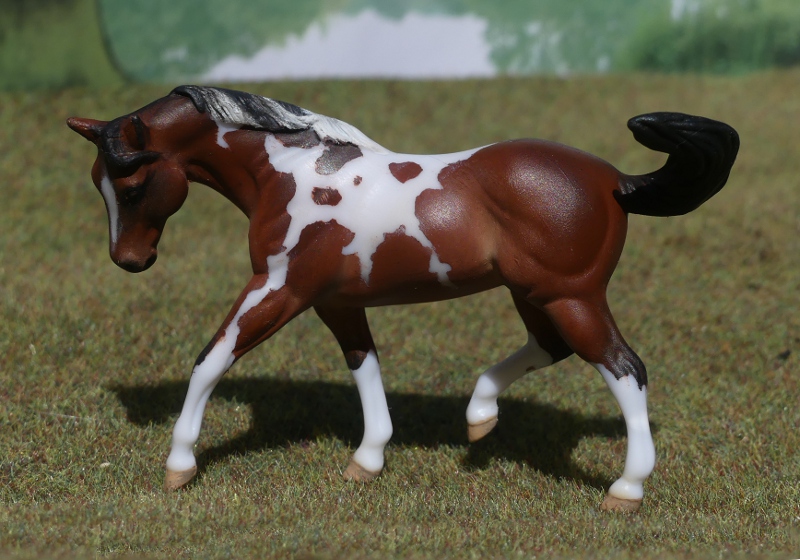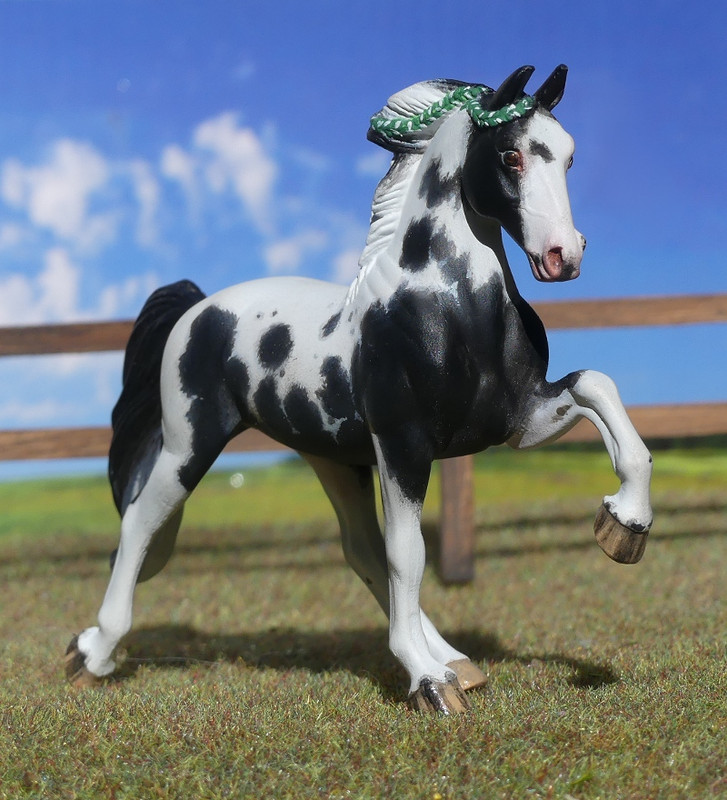I'm trying to catch up a little bit on the painted SMs which seem to be scattered in little groups all round my house - I've got no room left in the "custom mini" section of my shelves so they're currently tucked between Trad scale hooves, hanging out with Julip dogs and bunnies, decorating the mantelpiece and the top of the gas fire, and even balancing on piles of books! I'm going to have to do something about this to give the herd a proper home, but for now, I'll just make do with introducing them here and getting them onto the CM SM page of my website, so at least I'll feel like I've done something with the poor things!
First, we have a little group of piebalds and skewbalds - I didn't mean to paint so many in a row and I have done some solid colours since, honest!
The big bargain box of last year's mystery Stablemates brought with it several moulds I hadn't painted before, including this, my first ever custom of the Tennessee Walking Horse breed. A nice mould to paint, a little chunky in the legs but most of the moulds from this batch are - I've always wondered if Breyer asked for them to be made that way as they'd be more robust for children's play than the thinner legs of the G1 and G2 moulds.
The hardest parts to paint were the braids in mane and forelock, unlike the ASB's smooth braids, these have the plait detail pressed in, so you have to paint the colours exactly onto the marked out sections - very fiddly!
Her markings went a little bit blurry on this side as I had slightly too much paint on the brush when giving them a light dusting to soften the edges, but so many real life pintos have mottled or roany parts to their patches, I think I've got away with it!
I've named this one Stormy Autumn, and really love how she turned out. Bay is probably my favourite colour to paint, and the white markings make her that little bit more flashy and eye-catching.
Next up, my first on the new Cob. I've always had mixed feelings about this mould - on one hand it is very sweet, with that ponyish look and cute friendly face, and it's always nice to have a model representing the masses of random unknown-partbreds, the heinz57s, the riding school horses and the family pets. Model ranges usually focus on the high performance sport and show horses, and the specific breeds, which fill the catalogue pages and the collection shelves, so it's a change when we get a model of the kind of horse we might've grown up with, or learnt to ride on, or see in a field on the way to work.
And it's even better when that's a cob.
But... it's just not a very good example of a fully grown cob!
Take another look, and tell me that's not a youngster - the neck's very slim with not much topline or muscle, the shoulders are narrow and pinched, the quarters also look angular rather than rounded, and most tellingly, the withers are notably lower than the rump - you get a general impression that it's got some growing to do, a gelding colt which hasn't levelled out and matured, or built up muscle in all the right places. As that, it's fine. So I'm just going to imagine mine as being youngsters!
I painted this one up with less colour than usual; I find this hard because to get the white covering large areas well it has to go on first, then I'm left trying to get the colour bits neat and smooth within the patch shapes, it's always a difficulty and not always a success - there's usually some colour which escapes and then I try to paint over it but it spreads around and tints the entire side of the horse faintly pink/orange. This one just about escaped the worst of that cos I deliberately let his patches be a bit roany and mixed up with mapping and smudgeyness, but to be honest it's not as nice as I'd hoped.
A visit to a quarter horse stud a couple of years ago gave me my first look at western riding in person, and a new appreciation of the models which represent the particular movements found only in the working and showring western disciplines. Cutting or sliding stop poses make sense now, rather than seeming quite so outlandish and odd, and I think I enjoy my few western models a little bit more, now, than I did before. Which is good, cos my body box came with three of these to paint!
I have trouble finding a sandy-colour paint to use for duns, so this time I gave in and mixed my own : part golden yellow, part mushroomy grey-brown, and part beige, with more and more of the beige paint added to the mix to shade the pale areas. The white markings were added afterwards, with several layers of diluted paint so they'd go on smoothly with a small brush, as I hadn't done an overo for ages and this seemed a good breed to suit it.
Another pinto, another technique! This body was from the second series of blind bag mystery horses, and because the OF paintjob left so much bare white plastic exposed, I decided I could do something experimental with that, and use masking on the parts which were already white.
Instead of masking tape, which doesn't allow for over-fiddly shapes, I put on a layer of PVA glue with the mysterious pointy thing that comes in the packs of brushes I buy (it's a fine metal tip on a paintbrush handle, I've no idea what purpose they have in nail art but that's what my mini brushes are sold for so I'm guessing nail fans have a use for them!), making up the markings as I went along but being careful to keep all the glue on the parts which were white.
Once it's dry, just paint the horse bay, then peel off the glue and you're left with a neat little tobiano pinto pattern!
I put a few streaks into his mane, finished off his face and hooves, and left it at that. On some previous glue-masked paintjobs, I've gone along and added some feathering and mapping to the edges of the colour, but those were the basecoated white bodies, on this one I thought it might stand out weirdly against the bare plastic so I've left the patches sharp-edged.
Last one for now, another TWH, in piebald this time. Another one where the white was done first, but at least black is easier to apply inside the patch shapes, because it doesn't have to be shaded all over the horse, so there's no layering of different colours blended and smudged and mixed but trying to keep within the outlines - black is black and a couple of coats did the trick!
She's got one of those face markings with a patch of colour inside it, and striped hooves to match her ermine spots, but no name yet, I'm still thinking!









No comments:
Post a Comment